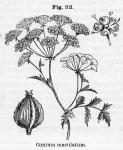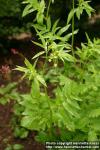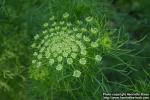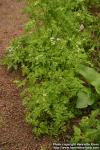
 Preparations:
Hemlock Poultice
- Tincture of Hemlock
- Juice of Hemlock
- Extract of Conium
- Fluid Extract of Conium
Preparations:
Hemlock Poultice
- Tincture of Hemlock
- Juice of Hemlock
- Extract of Conium
- Fluid Extract of Conium
"The full grown fruit of Conium maculatum, Linné," "gathered while yet green"—(U. S. P.) (Cicuta maculata, Lamarck). The leaves are official in the British Pharmacopoeia.
Nat. Ord.—Umbelliferae.
COMMON NAMES: Hemlock, Poison hemlock, Spotted hemlock, Poison parsley.
ILLUSTRATION: Bentley and Trimen, Med. Plants, 118.
Botanical Source.—Poison hemlock has a biennial, fusiform, whitish, fleshy root. Its stem is from 3 to 5 feet high, erect, round, hollow, glaucous, polished, and copiously spotted and dotted with dull purple. The leaves are tripinnate; the lower ones very large, several times pinnate, and bright-green, on long, sheathing foot stalks. The leaflets are ovate, lanceolate, pinnatifid, lower lobes incised. The flowers are numerous, small, white, all fertile, outermost very slightly irregular, and are arranged in erect, terminal, compound, many-rayed, smooth umbels. The general involucre is ovate, cuspidate, with membranous edges, consisting of from 3 to 7 lanceolate, reflected bracts, with whitish edges; the partial involucre of 3 or 4 oval, pointed, spreading bracts, with the inner side wanting. The petals are obcordate, with acute, inflected points, and 5 in number. The fruit is about a line and a half, or rather less in length, by a line in breadth; roundish-ovate, compressed, of a pale-green color; the primary ridges are elevated, sharp and undulated; the commissures and channels finely wrinkled. The whole plant exhales a disagreeable, virose odor, more especially when bruised (L.—W.).
History.—Hemlock inhabits Europe and Asia, and has been introduced in many parts of this country. It flowers from May to August. The leaves and seeds are the parts used. The leaves are best when collected during the flowering seasons of the herb; they should be speedily dried by a gentle heat, not over 47.7° C. (118° F.), and placed in closely covered vessels, to preserve them as much as possible from the influence of the atmosphere and light. If properly dried, the leaves should have a fine green color, with a disagreeable odor, less powerful than in the fresh plant, and a peculiar, nauseous, saline, and somewhat acrid taste. The fruit, or seeds, should be gathered shortly previous to ripening. Both the leaves and seed yield their virtues to alcohol or ether. The aqueous extract is uncertain; the alcoholic extract is the best, but even this becomes destitute of coniine in a few years (M). The fresh leaves and fruit should be employed in the preparation of the active constituent.
Description.—CONIUM (U. S. P.).—The fruit is thus described in the U. S. P.: "About 3 Mm. (⅛ inch) long; broadly ovate; laterally compressed; grayish-green; often divided into the 2 mericarps, each with 5 crenate ribs, without oil tubes, and containing a seed which is grooved on the face; odor and taste slight. When triturated with solution of potassium or sodium hydrate, conium gives off a strong, disagreeable, mouse-like odor"—(U. S. P.).
CONIUM LEAVES.—(See History and Botanical Source).
Chemical Composition.—The active principles of conium are the alkaloids, of which 5 have been identified (C. E. Sohn, 1894, Dictionary of Active Principles of Plants): Coniine (C8H17N), identified with conicine and cicutine; conhydrine (C8H17NO), discovered by Wertheim, in 1856; pseudo-conhydrine (C8H17NO), isolated by E. Merck, in 1891; methyl-coniine (C9H19N); and ethyl-piperidine (C7H15N). The mixed alkaloids may be prepared by distilling a mixture of strong solution of caustic potash and alcoholic extract of the unripe fruit, whereupon they pass over, forming an oily layer in the receiver. According to directions of J. Schorm (1882) the conium fruits, moistened with water, rendered alkaline with sodium carbonate, are distilled with steam under a pressure of 3 atmospheres. The distilled oil is neutralized with hydrochloric acid, evaporated, and treated with alcohol. After removal of the alcohol on the water-bath, an equivalent amount of caustic soda is added, and the alkaloids then shaken out with ether. The ethereal solution is reduced to a low temperature, whereby the bulk of conhydrine separates in the form of long needles. The remaining traces will evaporate with the ether, pure conicine remaining (Amer. Jour. Pharm., 1882).
Coniine, when pure, is an oily-like, transparent, colorless liquid, becoming brownish by oxidation, of specific gravity 0.86, with a very penetrating, tobacco-like odor, and a sharp, acrid, benumbing, and offensive taste. At ordinary temperatures it is volatile, disengaging ammonia, depositing a resinous matter, and losing its activity; its vapor excites a flow of tears. It is soluble in 90 parts of water, and forms a hydrate by uniting with about a fourth part of water, which, in cold, saturated solution, becomes turbid by heat owing to the separation of the water of hydration. It is very soluble in alcohol, ether, benzin, chloroform, benzol, the fixed and volatile oils, and also in weak acids, which it neutralizes. It boils at about 171° C. (340° F.), and distills over with water at 100° C. (212° F.). It strongly blues reddened litmus paper and forms soluble salts with acids, which, excepting the hydrochlorate, are difficult to crystallize. Caustic potash added to salts of coniine sets the base free, which is then recognized by its odor; heat produces the same effect on most of its salts. As to the behavior of coniine towards reagents, see Amer. Disp., last edition; also C. E. Sohn (see above).
Coniine possesses the same remarkable action on the spinal cord as hemlock itself. A few drops will suffice to kill a cat, rabbit, or young dog; a strong cat was killed in a minute and a half by 3 drops of it. Its effects are gradual paralysis, slight convulsive tremors, and death from suspension of the breathing, without any change in the appearance of the blood, and without any depression of the heart's action.
Coniine was observed by Giesecke as early as 1827, and obtained in the form of an impure sulphate. Geiger, in 1831, obtained it pure and recognized its alkaloidal nature. It is present in all parts of hemlock, probably in combination with malic acid (Husemann and Hilger, 1884). It is optically active, turning the plane of polarized light to the right. Its present formula was established, in 1881, by A. W. Hoffmann, and its synthesis was accomplished, in 1886, by Ladenburg, who first prepared inactive coniine (alpha-propyl piperidine (C5H9[C3H7]NH), and succeeded in isolating therefrom the active alkaloid by adding a crystal of the tartrate of the dextrogyrate alkaloid to the syrupy solution of the tartrate of the inactive alkaloid.
Conhydrine (C8H17NO), discovered by Wertheim, is an oxyconiine occurring in commercial coniine from which it separates on cooling to near 0° C. (32° F). Its melting point is 126° C. (258.8° F.).
Pseudo-conhydrine (C8H17NO) was discovered by E. Merck, in 1891, in the high boiling portions of crude coniine. It crystallizes in needles, is easily soluble in alcohol, ether, and chloroform, and fuses at about 98° C. (218.4° F.). Its boiling point is 230° to 232° C. (446°to 449.6° F.).
Methyl-coniine (C9H19N), an oily base, and associated with coniine, was found by Von Planta and Kekulé in hemlock (1854). It is a homologue of coniine, or rather of its isomer, paraconiine, prepared by Schiff, in 1871. G. Liljenstroem (Amer. Jour. Pharm., 1894), calls attention to the difficulty of accurately determining the quantity of the alkaloid in extract of conium by means of continuous extraction with ether, owing to the volatility of coniine, even though a reflux condenser is employed. He suggests that a known amount of centinormal acid be placed in the receiver, which readily absorbs coniine, and to titrate back the excess of acid. Wertheim obtained from fresh seeds about 0.20 per cent of pure coniine.
Action, Medical Uses, and Dosage.—Conium is narcotic, possessing, however, properties somewhat similar to those of belladonna. On account of the former difficulty in procuring good preparations of this plant, it has not been so much used nor its virtues so fully investigated, as with some of its congeners. The symptoms produced by its use are thirst, dryness of the throat, dizziness, sickness at stomach, sinking, benumbing feelings, and more or less prostration of the muscular system. If its use be continued, or in large doses, the pupils become dilated, there is a general paralysis, rendering talking and breathing difficult, with coma, or convulsions terminating in death. In about 30 minutes from its administration, its effects will generally appear, and continue from 10 to 40 hours. It is supposed to effect its results by exhausting the nervous energy of the spinal cord and voluntary muscles. It is used for promoting sleep, and will be found extremely useful in allaying excessive action of the heart in hypertrophy of this organ; a pill of 1 or 2 grains of the extract producing a calm, soothing influence, followed by a diminution or removal of the palpitation or augmented action. Indeed, all affections attended with an excited or excitable condition of the, nervous and vascular systems, will be benefited by its use. Dr. J. Harley considered conium as a depressor of the muscular movements, tranquilizing and renovating the whole muscular system—being to the corpora striata, the smaller nervous centers, and the whole of the motor tract, just what opium is to the brain. It depresses the motor function of the third nerve, causing a lazy movement of the eyes, and sometimes strabismus, with imperfect adjustment of the refracting media of the eye. It affects the sedentary and strong more than the delicate and active, so that its action is influenced more by the muscular activity than by the muscular power. It has no pure cerebral effects, but diminishes irritability of the spinal cord without disturbing the sensory functions. It has no direct action on the sympathetic; improves nutrition; and can not be detected in the urine, breath, or feces. He considered it preeminently useful in laryngismus stridulus, convulsive cough, and in tetanic muscular conditions. The dose must be proportioned to the degree of motor activity of the child or adult; by its use we may almost measure the bodily activity of the individual. To a child 21 months old he has given 20 minims of the prepared juice, and gradually increased it to 2 ½ fluid drachms.
Conium has in times past been lauded in cancer, and, while it undoubtedly has influenced growths pronounced cancerous, it is not known to have effected a cure. The pain of cancer, however, is alleviated by it, and it undoubtedly affects tumors of the mammae, even when they amount to scirrhus. Conium has been used to check lactation, thus showing its specific action upon the mammary glands. Ovarian torpor, giving rise to scanty menses, and sterility in the female, and in the genital feebleness of the male, accompanied with an unpleasant erethism, or where lack of sexual activity is due to passive testicular venous engorgement, conium is said to be efficient when given in small doses. Glandular enlargements sometimes yield to the alterative influence of this drug, and while not generally efficient in syphilis, as some of its admirers claim, it is useful in allaying the pains which accompany that affection. In rheumatism and neuralgia, Rx Specific conium, gtt. v to x; aqua, fl℥iv. Mix. Sig. Dose, a teaspoonful as often as necessary, or give from ½ to 2 grains of the English extract. Chorea and epilepsy, due to sexual abuse, and whooping-cough and acute mania are states in which it is asserted useful. It has been variously used in cachectic and depraved states, either as a palliative or for its curative action. Large doses are contraindicated by debility.
In consequence of the action of conium on the spinal marrow, it lessens the venereal appetite. It likewise lessens the secretion of milk. In the neuralgic pains attending carcinomatous affections it usually gives relief, probably, from its causing relaxation of muscular fibers; sometimes, however, it has exerted no influence whatever, in palliating them. In scrofula, goitre, and, indeed, in all tuberculous affections, it will be found very effectual given in combination with the iodide of iron. It enters into the compound plaster of belladonna, an excellent preparation, which Prof. King used for many years. Coniine, the active principle, is not extensively used in medicine. The hydrochlorate, benzoate, and, best of all, the hydrobromate have been most used, the latter particularly in whooping-cough and sciatica. Dr. Reid gives the following formula for toothache: Take of coniine, 1 drop; rectified alcohol, essence of cinnamon, each, 4 drops. Mix. This is applied by means of a camel's hair pencil. It relieves the pain instantly, but produces no effect where the nerve is not exposed by caries; a few minutes after its application there will be vertigo, difficulty of swallowing, etc., which usually cease in about 10 or 20 minutes. It should not be too frequently, nor too largely applied. The leaves have likewise been employed externally as a poultice to painful tumors, ulcers, neuralgic and rheumatic pains, etc. For painful parts the following is useful: Rx English extract of conium, ʒij; petrolatum, ʒvj. Mix. Apply. In intermittent fever, Dr. King frequently employed the following pill when quinine alone failed: Take of sulphate of quinine, 10 grains; inspissated juice of conium, 15 grains. Mix and divide into 20 pills, of which 1 pill may be given every 1 or 2 hours, until the effects of the conium have commenced, after which give 1 pill every 4 or 5 hours, according to its influence. The aqueous extract of the plant is worthless; the inspissated juice, or the ethereal extract, are alone valuable only when they are carefully and properly prepared. A strong solution of the. inspissated juice, or the juice of the fresh leaves, coated over the parts daily, for 5 or 6 days, will cure the itch. Dose of the leaves and inspissated juice, from 1 to 3 grains, 3 or 4 times a day; of the ethereal extract, which is an elegant extract of a rich, dark-green color, from ⅛ to ½ grain; coniine, 1/30 to ⅙ grain; coniine bromohydrate, 1/30 to ⅙ grain; coniine hydrochlorate, 1/30 to ⅙ grain; coniine benzoate, 1/30 to ⅙ grain; specific conium, 1/10 to 3 drops.
Specific Indications and Uses.—To relieve nervous excitation and give rest; neuralgic or rheumatic pains in the old and feeble, or where there are caco-plastic deposits; pain in stomach; pain of gastric ulcer; nervousness and restlessness.
Related Species.—Cicuta maculata, Linné, Spotted water-hemlock, Spotted parsley, Spotted cowbane, Beaver poison, Musquash root, American water-hemlock. North America. This plant differs from the following in having a purple-spotted stem, wider leaflets, and long, tuberous, fleshy roots. A volatile alkaloidal principle, believed to be coniine, was isolated by J. E. Young (Amer. Jour. Pharm., 1855, p. 289). Mr. Glenk, in 1891, made a complete analysis of the fruit. The volatile oil was investigated recently by Mr. Stroup and found to consist mainly of terpenes (see Amer. Jour. Pharm., 1894, p. 236).
Cicuta virosa, Linné (Cicutaria aquatica, Lamarck); Water hemlock, Cowbane.—This plant grows in wet situations from Canada north. Its rhizome is short, somewhat ovate, thick, and hollow, and has attached rootlets arranged in circles. The taste of the plant is aromatic and acrid, and its odor slightly aromatic. The plant, but not the root, as shown by Van Ankum's researches (1868), contains cicutine, a volatile alkaloid. Cicutoxin is a name applied by Boehm and Trojanowski, in 1887, to a soft, amorphous and tenacious yellow substance existing in the rhizome to the extent of 3.5 per cent. Cicuta is used as a local anodyne in rheumatic and neuralgic complaints, and gout. Seldom employed in medicine.
Sium latifolium, Linné; Water parsnip.—Europe and California. Root contains a poisonous resin, volatile aromatic oil, and a volatile base (analyzed by A. R. Porter and N. Rogers), and said to resemble the pastinacine of Wittstein (see Amer. Jour. Pharm., 1876, pp. 348 and 483). Reputed narcotic and has been employed in skin diseases.
Sium lineare, Michaux, of North America, and Sium angustifolium, Linné, of North America and Europe, are similar plants and poisonous.
Sium nodiflorum, Water parsnip.—A European umbelliferous, aquatic perennial, the juice of which was found to be useful in various cutaneous affections, was formerly regarded as poisonous. The dose of the juice as given by Withering, however, was 3 or 4 ounces daily. It is diuretic and exerts a good influence upon scrofulous lymphatic enlargements. This plant is also found in the southern states.
 Sium sisarum, Skirret.—Habitat China, cultivated in Europe, where it is eaten as a salad. Its root is sweetish and aromatic. Recommended as a diet in pulmonic complaints.
Sium sisarum, Skirret.—Habitat China, cultivated in Europe, where it is eaten as a salad. Its root is sweetish and aromatic. Recommended as a diet in pulmonic complaints.
 Ammi Visnaga, Lamarck; Tooth-pick plant.—South Europe, north Africa, and east Asia. This aromatic plant yields a bitter, crystalline, colorless glucosid, called kelline, isolated in 1878 by Ibrahim Mustapha. Th. Malosse, in 1881, found 2 percent of an oily, acrid principle which he called visnagol; 3 crystalline, partly alkaloidal principles, collectively named visnagin; a fixed oil (10.5 per cent) containing ammistearic acid, etc. (Amer. Jour. Pharm., 1881, p. 640, and 1886, p. 300). Kelline occasions vomiting, impeded respiration and cardiac irregularity. This plant is the El Kellah of the Moors. An 8 per cent decoction of the seeds, taken internally, is reputed to be a cure for troubles dependent on a uric acid diathesis, especially rheumatism. It relieves pain in the kidneys and urinary tract by its obtunding powers. Locally, this decoction has been applied in rheumatism of the joints to allay pain, and as a wash for buccal ulcerations.
Ammi Visnaga, Lamarck; Tooth-pick plant.—South Europe, north Africa, and east Asia. This aromatic plant yields a bitter, crystalline, colorless glucosid, called kelline, isolated in 1878 by Ibrahim Mustapha. Th. Malosse, in 1881, found 2 percent of an oily, acrid principle which he called visnagol; 3 crystalline, partly alkaloidal principles, collectively named visnagin; a fixed oil (10.5 per cent) containing ammistearic acid, etc. (Amer. Jour. Pharm., 1881, p. 640, and 1886, p. 300). Kelline occasions vomiting, impeded respiration and cardiac irregularity. This plant is the El Kellah of the Moors. An 8 per cent decoction of the seeds, taken internally, is reputed to be a cure for troubles dependent on a uric acid diathesis, especially rheumatism. It relieves pain in the kidneys and urinary tract by its obtunding powers. Locally, this decoction has been applied in rheumatism of the joints to allay pain, and as a wash for buccal ulcerations.
 Anthriscus Cerefolium, De Candolle (Scandix Cerefolium, Linné; Chaerophyllum sativum, Lamarck); Chervil.—A European annual raised in gardens and used for greens. A volatile oil gives to the plant a strong, but pleasant odor, and a sharp, yet feebly bitterish taste. Externally, it has been applied to bruises, swollen mammary glands, and other local tumefactions; internally in phthisis, scorbutus, scrofula, dropsy, and cutaneous disorders. It is diuretic, emmenagogue, and deobstruent. Like other species of Chaerophyllum, its leaves are sometimes collected for conium, though the plants do not greatly resemble each other.
Anthriscus Cerefolium, De Candolle (Scandix Cerefolium, Linné; Chaerophyllum sativum, Lamarck); Chervil.—A European annual raised in gardens and used for greens. A volatile oil gives to the plant a strong, but pleasant odor, and a sharp, yet feebly bitterish taste. Externally, it has been applied to bruises, swollen mammary glands, and other local tumefactions; internally in phthisis, scorbutus, scrofula, dropsy, and cutaneous disorders. It is diuretic, emmenagogue, and deobstruent. Like other species of Chaerophyllum, its leaves are sometimes collected for conium, though the plants do not greatly resemble each other.


